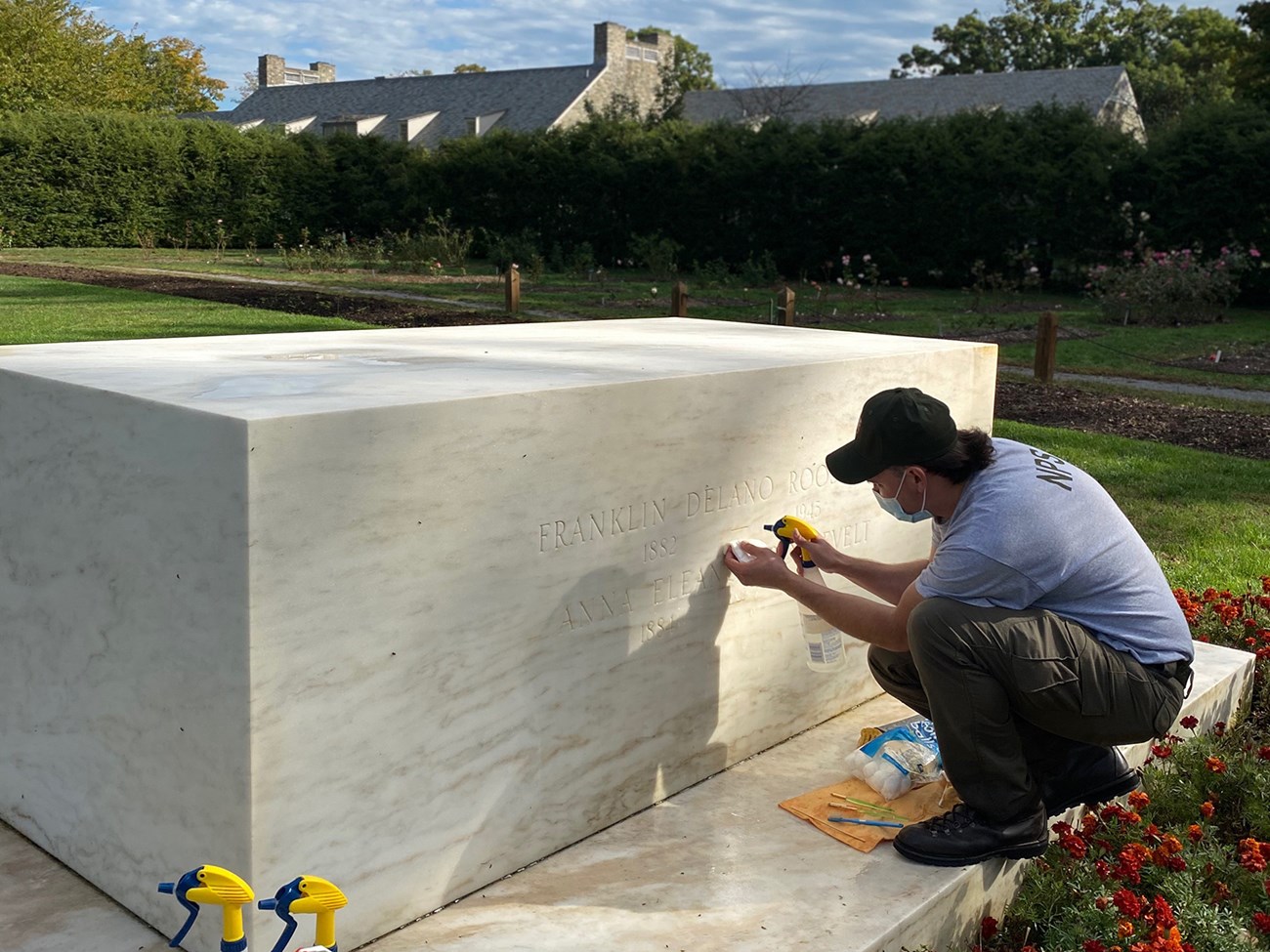Last updated: October 2, 2020
Article
Preserving the Roosevelt Grave Monument

While burial sites are often considered to be perpetual, their most prominent feature—grave markers—are not. They weather and naturally decay from exposure to agents of deterioration. All grave marker materials deteriorate when they are exposed to weathering such as sunlight, wind, rain, high and low temperatures, and atmospheric pollutants. The National Park Service routinely assesses the condition and provides regular preventive maintenance treatments to minimize deterioration and support the preservation of Franklin and Eleanor Roosevelt’s final resting place.
Historic grave markers are made from a wide variety of masonry materials; some are naturally occurring and others man-made. Although there are notable exceptions, most masonry materials are durable, have high compressive strength, and are resistant to weathering. The Roosevelt grave monument is made of marble. Marble contains calcium carbonate and is a mineral property that influences weathering and the selection of materials and procedures appropriate for its cleaning and protection.
Weathering results in deterioration in a variety of ways. Marble is softer and more porous than other stones, such as granite. These materials are more vulnerable to weathering. Climate plays an important role in weathering processes. Depending upon the climate, grave markers are exposed to rain, snow, sleet, ultraviolet light, humidity, high and low temperatures, and wind. All of these forces can damage marble.
Microorganisms such as algae, fungi, and lichens also affect grave markers. Microorganisms hold in moisture and some produce acids. With acid-sensitive materials such as marble, the result is surface erosion. Sometimes the organisms use the material as a food source, dissolving minerals in the stone.
Harsh cleaning products and techniques can have a detrimental effect on grave markers. Acidic cleaners such as muriatic acid can dissolve minerals in many masonry materials. Alkaline cleaners, such as bleach, are notorious for leaving residual salts that are deposited on the surface. Both acidic and alkaline cleaning can result in staining, especially if rinsing is inadequate. Using high-pressure water can also damage materials, further increasing their vulnerability to weathering.
While the visual effect of pollution is often discoloration, less apparent is the potential damage caused by pollution to the grave marker materials themselves. Most rain is slightly acidic and becomes more acidic when pollutant gases are present. Acid rain damages materials containing calcium carbonate, such as marble, resulting in surface loss or erosion. When erosion is severe, the grave marker inscription, and other decorative elements, may become indistinguishable.
Maintenance is essential to the long-term preservation of historic grave markers. The principal components of a maintenance program include regular inspections, cyclical, and prioritized maintenance work. At the Home of Franklin D. Roosevelt National Historic Site, tasks such as cleaning on a cyclical basis are part of the maintenance program to protect the monument from future deterioration.
Gentle cleaning is carried out to remove soiling, staining, and contamination. Cleaning improves the visual appearance and sometimes reveals existing problems such as erosion and cracks before conditions become more severe. Although cleaning is beneficial, the use of improper materials and techniques can cause great damage.To avoid a heavy build-up of soiling that might require aggressive cleaning procedures, regularly scheduled cleaning is carried out by the park’s museum staff. To help remove stubborn soiling and dirt, we use soft, natural bristle scrub brushes and a biodegradable solution that is pH neutral and contains no salts, bleach or acids to clean any biological and pollution staining that has occurred over the course of the year.
Regular maintenance is key to extending the life of the grave monument and honoring the legacies Franklin and Eleanor Roosevelt.
Sources
Mary F. Striegel, Frances Gale, Jason Church, & Debbie Dietrich-Smith, Preserving Grave Markers in Historic Cemeteries (National Park Service, Technical Preservation Services, 2016).
